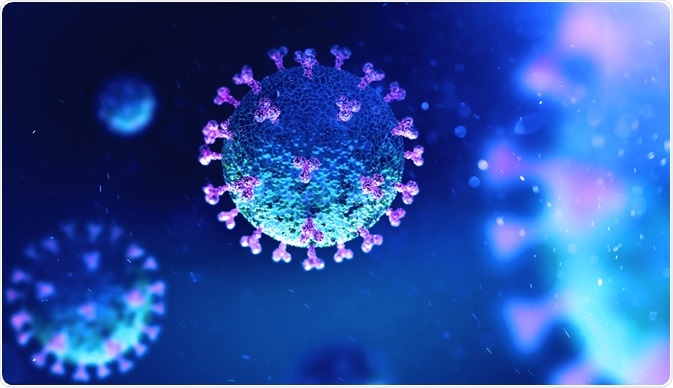The discovery of vaccines has no doubt transformed modern medicine, opening up an entirely new avenue of preventative techniques. To date, two diseases have been eradicated through mass vaccination: smallpox and rinderpest. It is hoped that continued vaccine development will further protect the health of the human population from current and future diseases that have yet to arrive.
.jpg) Image Credit: CrispyPork / Shutterstock.com
Image Credit: CrispyPork / Shutterstock.com
Last year, the SARS-CoV-2 virus emerged. As it spread rapidly across continents, research teams around the world strived to rapidly develop a vaccine to curb the spread of the virus and allow countries to relax stringent lockdown measures.
To develop a new vaccine for a previously unknown virus scientists have had to understand the human body’s adaptive immune response to exposure to the SARS-CoV-2 virus. As the virus is new, scientists have had to investigate how human T cells respond to SARS-CoV-2 as this foundational information does not exist with a new disease. Therefore, there has been an urgent need to gain information about T cell responses to the SARS-CoV-2 in a short time.
Additionally, as different research teams have developed their individual vaccine systems, it has been important to predict which ones will prove most effective, provide the necessary long term protection, and be safe to be administered in humans. Our current knowledge of human immunological mechanisms is still fairly scarce, which can make it challenging to predict how effective different vaccine targets will be.
Flow cytometry provides a method of identifying potential targets for vaccines (including for SARS-CoV-2), as well as for demonstrating how effective a developing vaccine may be by revealing how the immune system responds to different strategies.
Overall, we know that effective vaccines must invoke all three types of immune response, including the innate immune response, the adaptive immune response, and the immune memory. Flow cytometry provides a tool to measure all three of these responses, helping to indicate the potential efficacy of a novel vaccine.
Using flow cytometry to understand the human immune response to SARS-CoV-2
With the rapid emergence of SARS-CoV-2 around the world, scientists have needed to rapidly gain foundational information about T cell responses to the virus. Flow cytometry has offered a method of gaining rapid insight into these responses.
Flow cytometry is an analytical technique that has become fairly commonplace in laboratories worldwide. It is most often used to determine the expression of the cell surface and analyze the expression of intracellular molecules, it is also used to characterize and quantify different cell types within a heterogeneous cell population. Flow cytometry is also effective at assessing the purity of subpopulations and measuring cell size and volume.
To conduct these analyses, flow cytometry measures the fluorescence intensity produced by antibody-detecting proteins that have been fluorescent-labeled. The method involves a staining procedure where a single-cell suspension is created from a tissue sample or cell culture. The method has numerous applications including the identification of vaccine targets. Now, with the emergence of the COVID-19 pandemic, flow cytometry is being utilized to develop a fundamental understanding of human antigen-specific SARS-CoV-2 T cell responses.
 Image Credit: Andrii Vodolazhskyi / Shutterstock.com
Image Credit: Andrii Vodolazhskyi / Shutterstock.com
Using flow cytometry to map T cell epitopes
The first step of gaining this foundational information is to quantify the CD4+ and CD8+ T cells available that are specific to the virus in a sample. This information gives key insights into SARS-CoV-2 immunity and pathogenesis. In addition, this information is vital to vaccine design and the selection of vaccine candidates. Recent research has found that epitope pools can detect CD4+ and CD8+ T cells in 100% and 70% of recovering COVID-19 patients.
An epitope is an antigenic determinant, it is the part of the antigenic that the immune system recognizes, mostly by antibodies, B cells, and T cells. Flow cytometry has emerged as a useful tool for modern epitope mapping. It both identifies T-cell epitopes and provides a detailed analysis of the subsets of T-cells that respond. This enables scientists to identify markers of interest.
COVID-19 vaccination development with flow cytometry
Recently published research has been successful in using flow cytometry panels to develop the immunological cellular profile of patients who have recovered from COVID-19. Scientists at the Center for Infectious Disease and Vaccine Research, La Jolla Institute for Immunology, California, found that CD3+ cell frequency was marginally increased in recovered patients compared with those who had not been exposed to the virus.
They also found that frequencies of CD19+ cells were slightly decreased. No difference was observed between the two groups in frequencies of CD4+ or CD8+ T cells and of CD3–CD19– cells or CD14+CD16– monocytes. This evidence helps scientists understand how the human immune response is activated by SARS-CoV-2, forming the foundational information that is required to develop effective vaccines.
The future of vaccine development
Current research demonstrates that flow cytometry is vital to the development of new vaccines by enabling scientists to identify vaccine targets. The use of flow cytometry in vaccine development, therefore, will be crucial to the rapid development of COVID-19 vaccines, as well as future infectious diseases, autoimmune diseases, and cancer.
Sources
- De Rosa, S., 2012. Vaccine applications of flow cytometry. Methods, 57(3), pp.383-391. https://www.ncbi.nlm.nih.gov/pmc/articles/PMC3349786/
- Grifoni, A., Weiskopf, D., Ramirez, S., Mateus, J., Dan, J., Moderbacher, C., Rawlings, S., Sutherland, A., Premkumar, L., Jadi, R., Marrama, D., de Silva, A., Frazier, A., Carlin, A., Greenbaum, J., Peters, B., Krammer, F., Smith, D., Crotty, S. and Sette, A., 2020. Targets of T Cell Responses to SARS-CoV-2 Coronavirus in Humans with COVID-19 Disease and Unexposed Individuals. Cell, 181(7), pp.1489-1501.e15. www.cell.com/.../S0092-8674(20)30610-3
- Hoffmeister, B., 2003. Mapping T cell epitopes by flow cytometry. Methods, 29(3), pp.270-281. https://pubmed.ncbi.nlm.nih.gov/12725792/
Further Reading
Last Updated: Feb 5, 2021